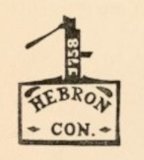
The Hebron Historical Society
Hebron, Connecticut
Enjoy Hebron - It's Here To Stay ™


Enjoy Hebron - It's Here To Stay ™

Dorothy Gantner Giglio has donated an original, 32-page booklet, “A Historical Sketch of the Congregational Church in Gilead, Conn., From the First Settlement of the Town by the English,” to the Hebron Historical Society. Written by then-pastor, Reverend Josiah A. Mack, it was read before the Tolland Congregational Association on June 4, 1878.
This valuable document is significant in many ways: we learn great detail about Gilead’s three longest-serving ministers from its inception until 1856, and we get a glimpse on how the church functioned from the early 1700’s until Mack’s sermon in 1878.
Mack traces the split in Hebron’s two Congregational churches back to Dr. Benjamin Pomeroy and the “Revival Movement.” Pomeroy’s first home later became the Porter Hotel in the center of town, but while he owned it, the second floor “was like an open chapel” for the Revivalists. Pomeroy’s teachings were suspect; so much so that he was arrested on a warrant issued by the Connecticut General Assembly in 1742. Many Hebron residents supported him and his teachings during this time.
Others didn’t agree; votes taken in 1734 and 1735 to divide the Hebron parish failed. Finally, in 1747, Hebron voted to set off what is now known as the “Gilead” section of town as a distinct ecclesiastical society. In May 1748, the Gilead Church was formally incorporated, and a church site was identified. All of this had to be approved by the General Assembly, because there was no separation of church and state at that time. A tax of 6 pence per pound was voted to pay for preaching. In September 1748, the 20-23 members of the new parish also voted to set aside funds to build a church and school.
Gilead next sought a minister, although “ministerial tramps were not encouraged.” In addition, the call for a minister advertised “Not one drunkard [can be found] in the entire parish.”
Part-time preachers came and went. Finally, in 1752, Elijah Lothrop, who was only 27, was ordained pastor. His contract called for the use of 40 acres of land, and an annual salary of £500 in “old tennor money” (equivalent to £60 in then-lawful currency.) A large man, Lothrop led the congregation through the tumultuous Revolutionary War. But, as noted in contemporary poetry, his congregation frequently fell asleep during sermons!
Lothrop served Gilead for 45 years, collapsing at the pulpit in his final sermon. He was replaced in 1799 by Nathan Gillett, also 27 years old. “The giants of the day took part in his ordination,” notes Mack. Gillett was paid an annual salary of £100, again coming from a local property tax for preaching. He soon married Lydia Jones, daughter of wealthy Hebron farmer, Captain Samuel Jones. The Gilletts built a home and farm just “rods” south of the church. According to Mack, in 1878 the Gilead post office was located at the old Gillett farm.
Giglio has also donated the original church ledger book that was kept during Gillett’s ministry, but that is a story in and of itself!
After 25 years of ministry, Gillett was dismissed in 1824, and in 1825, Charles Nichols was ordained. Gilead took a chance on young Nichols, a poor seminary student who had not yet graduated. It was a good fit, and Nichols ultimately served the parish for 31 years, along the way marrying Louisa Post, widow of John Post.
Gilead Congregational Church, a parish of “the hardest workers in Hebron,” had enjoyed the consistent services of just three outstanding ministers for over a century. But this small detail contributed greatly to the stability and growth of the Gilead we know today.
Mack documents other previously unknown details; the full 32-page sermon is available online at www.HebronHistoricalSociety.org. In particular, he gives a learned discourse on the changes in the state-church relationship between 1700 and 1870, and notes that by his time, churches were independent and opportunities for laymen were finally abundant, not state-controlled as they had been in Hebron’s founding days.